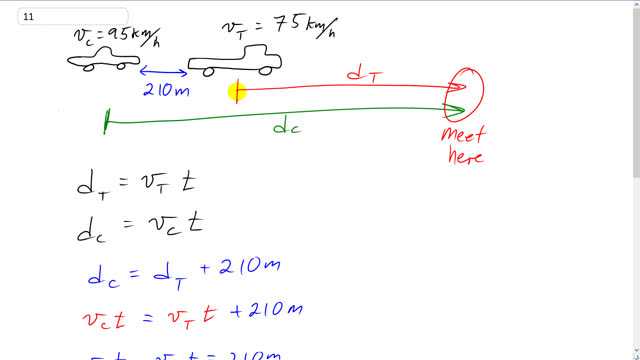
A car traveling 95 km/h is 210 m behind a truck traveling 75 km/h. How long will it take the car to reach the truck?

In order to watch this solution you need to have a subscription.
This is Giancoli Answers with Mr. Dychko. This car and this truck are going to meet here at this point here and the truck will travel the distance— subscript T for truck— and the car is going to travel this distance here in green— d subscript C for car and the distances are gonna be different. The car is gonna travel 210 meters further than the truck and that's what I'm saying here; the distance that the car travels is the distance the truck travels plus the 210 meters that it's initially behind the truck. And the distance the truck travels is the speed of the truck multiplied by some time; the distance the car travels is the speed of the car multiplied by the same time; time does not get a subscript T or C because they travel for an equal period of time, they just happen to cover different distances because they have different speeds. and we are gonna calculate what the time is that will make this happen. So we know that the distance the car travels is gonna be 210 meters more than the distance the truck travels and we'll substitute for the distance of the car as speed of the car times time and then distance to the truck is gonna be speed of the truck times time and then we'll take this term to the left side by subtracting it from both sides giving us speed of the car times time minus speed of the truck times time equals 210 meters; factor out the t to get this next line here and we have t times v C minus v T equals 210 meters and then we'll divide both sides by this difference in speeds so that we can isolate the time and it cancels on the left and we have time is 210 divided by the difference in speeds. So it's 210 meters times 1 kilometer for every 1000 meters because we want the units to be the same on the top and bottom so we need kilometers on top to match with the kilometers per hour on the bottom and we'll end up with units of hours. So we have 210 times 1 kilometer for every 1000 meters divided by 95 kilometers per hour minus 75 kilometers per hour—that's speed of the car minus speed of the truck— and that gives us 0.0105 hours and we'll turn that into a unit that makes more sense by multiplying by 3600 seconds for every hour giving us an answer of 38 seconds for the car to catch up to the truck. And well, there you go.